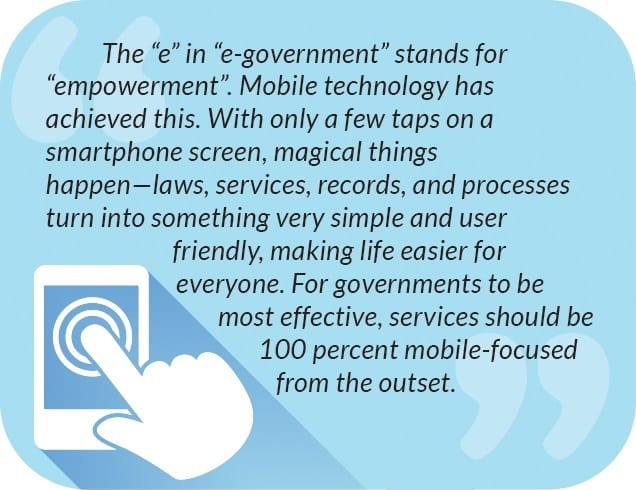Mobile devices are transforming the way citizens interact with their
governments—from using digital IDs for access to program information to crowdsourcing apps to improve city services. As mobile usage rises, citizens are demanding more exclusively mobile experiences from their governments—ones that move beyond basic apps and optimizing web pages for devices. To better serve their mobile stakeholders, governments will be required to adopt a mobile-centric approach as part of an overall digital, e-government strategy.
The case for a mobile approach is driven by consumer expectation, opportunities to improve service delivery, increased transparency through easy access to information, and new products and services that are co-created with citizens. Mobility makes government more accessible, affordable, collaborative, and convenient. As part of an e-government strategy, mobile programs give governments the opportunity to increase the efficiency of their services externally and to improve productivity internally.
Rather than treating the mobile device as an additional channel or touchpoint, the focus should shift to a mobile-only approach that complements a streamlined, omni-channel experience for users. While forward-looking governments are making it possible for citizens to complete transactions using their mobile device, the public sector lags behind the private sector when it comes to embracing mobility to maximize user experience.
According to research, the number of consumer mobile transactions is due to rise 65% between now and 2016. Mobile bank cards will replace physical bank cards. QR codes and Near Field Communications (a wireless communications technology that enables mobile devices to communicate based on proximity) allow for payments using a SIM card. These technologies are already expanding to support other uses with great potential for government applications for identification, transportation, and ticketing.
Just as mobile devices empower citizens with flexible access to programs and services, they also enable civil servants to do their jobs more effectively. Mobility enhances productivity by providing secure, remote access to government systems on a self-service basis. Using mobile devices, employees can stay productive on the go, wherever they are.
Mobile-centric programs help front line workers do more with less. Ideally suited for caseworkers, first responders, and law enforcement officers, mobility increases responsiveness by providing immediate access to accurate information and resources. Expedited decision making improves efficiency, decreases response times and, in some cases, saves lives. Manual labor around paperwork and data entry is minimized—saving time and money.
In a recent report issued by ICF International, 93% of U.S. federal government employees identified digital technology as being a critical factor in improving their productivity, with three-quarters of them relying on a mobile device and half using their own personal devices for business purposes. The report finds that federal workers require new and available technologies to enhance engagement and satisfy the demands of an increasingly mobile workforce.
Both internally and externally, users want an intuitive and consistent mobile experience that delivers value as part of the overall e-government experience. The public sector needs to adopt a mobile-centric mentality. One of our customers—and a true digital innovator—Sergi Jerez the Director of Mobile, eGovernment y Data, for the City of Barcelona, eloquently summarizes this approach:

City of Barcelona e-government quote
But where should agencies start when creating a mobile engagement strategy? Here are a few high-level recommendations:
- Dedicate resources from both the business and IT to developing a
mobile strategy. - Design your solution(s) to meet user or citizen needs. Address
their key pain points. For example, focus on the need for more
efficient updates from case workers in the field. - Provide access to accurate information about end users and mobile
consumers. Strive for alignment across departments and agencies and
a holistic view of citizen data, for example. Enterprise Information Management (EIM) helps
to consolidate structured and unstructured information for a single
source of the truth. - Map citizen or user journeys. Apply embedded analytics to
cultivate insight into behavior and identify usage patterns and
trends. What devices do users prefer? What channels do they use? Draw up detailed personas and scenarios for use. - Establish your mobile-centric engagement strategy and identify key
objectives. Make sure this strategy is integrated effectively with
your overall e-government strategy to streamline experience and efficiency. - Develop the mobile experience using technology as an enabler
(focus on the experience, not the technology). - Measure outcomes against desired results and identified objectives.
- Refine your delivery of the experience.
Mobile technology promises more efficient access to information, resources, and services. The number of access points to information that mobile introduces, however, also serves to complicate programs and policymaking. Mobile information in all its formats needs to be securely managed. To find out more about mobile access to information systems, mobile security, and leaders in mobile innovation, read my book: e-Government or Out of Government.
Contact us to discuss any of our targeted government solutions.




